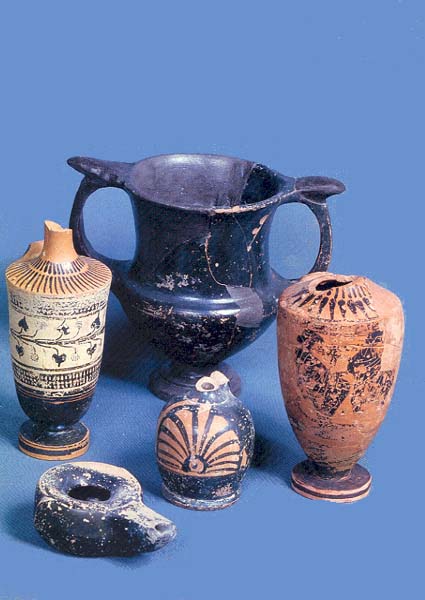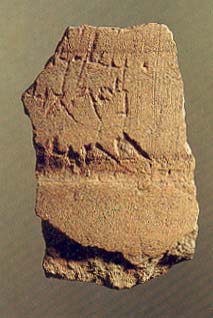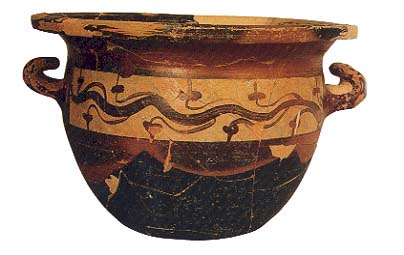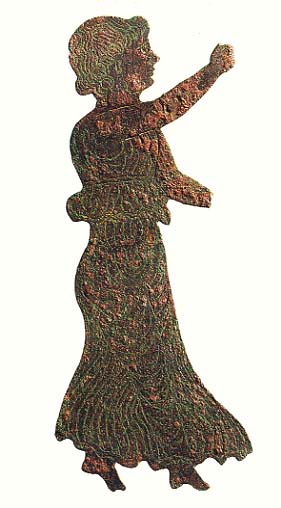The Many Masters of Dor, Part 3: The Persistence of Phoenician Culture
038
039

Twelve years of excavation have barely begun to uncover the 3,900 years of history buried at Tel Dor. Located 12 miles south of Haifa, on Israel’s Mediterranean coast, this 45-foot high mound contains the largest Phoenician city in a good state of preservation. Dor was not exclusively a Phoenician city, however. Although Phoenician culture dominated Dor for some 800 years, practically every major people of the region occupied or ruled the site at one time or another, as excavation director Ephraim Stern shows in his three-part article.
In the first two parts, Stern traced Dor’s history from its Canaanite roots, in the 20th century B.C.E., through a series of conquests by Sikils (a Sea Peoples tribe), Phoenicians, Israelites and Assyrians. Picking up the story in 733 B.C.E., this final installment looks at a succession of absentee landlords—Assyrian, Babylonian and Persian—who ruled Dor until the city’s complete Hellenization in the third century B.C.E.

After the Assyrian conquest of Dor in 733 B.C.E., the area became an Assyrian province consisting of the Carmel and Sharon coasts, with the capital at Dor. Another Assyrian province consisted of the Galilee and the Jezreel Valley, with its capital at Megiddo. Later, in 721 B.C.E., when the Assyrians captured the Israelite capital at Samaria, that region too became an Assyrian province. Assyrian governors were assigned to each province. The annals of the Assyrian kings list the names of the governors of the different provinces of the empire, including Megiddo and Samaria, but not Dor. Because of this, some scholars doubt that Dor was an independent province and suggest that it was administratively subject to the province of Samaria, or perhaps to the king of Tyre. In a treaty between King Esarhaddon of Assyria and King Baal of Tyre in 676 B.C.E., Dor is described as a city on the southern frontier of Tyre and is ceded to the king of Tyre. A comparison of the excavation results at Dor with those from Megiddo and Samaria leaves little doubt, however, that Dor was indeed a provincial capital in the Assyrian period, as well as later, because the results at all these cities are almost identical.

After the Assyrians destroyed Dor in 733 B.C.E. (and presumably deported many of its inhabitants in accordance with Assyrian custom), the city was soon rebuilt. It seems that the Assyrians, who had no navy or maritime expertise, needed the cooperation of the Phoenicians to develop their trade with the maritime 040states of the Mediterranean. At one point, according to an Assyrian stela of Sargon II found at Kition in Cyprus, the Assyrians also ruled Cyprus. The Assyrian literary evidence is confirmed by excavations on Cyprus. The Assyrians no doubt reached the island only with active Phoenician assistance, and their continued rule of the island was heavily dependent on the Phoenician fleet. The rebuilding of harbor cities like Dor in the areas under direct Assyrian control was probably a matter of great urgency for several reasons: to develop maritime trade, to realize taxes levied on these installations and to retain control of overseas territories. The Assyrians also needed these harbors to supply food and equipment to their armies in Judah and, later, to their army and administrative personnel in Egypt when that country was finally conquered. In the course of the Egyptian campaign, the Israelite coast became a way station; and its ports, including Dor, served as supply depots.
The Assyrians rebuilt the offset-inset wall after Dor’s destruction and attached a new eastern gate built directly over Ahab’s old four-chambered gate. The new gate had a different plan, however. Instead of a four-chambered gate, the new gate had only two chambers, one on each side of the passageway. These chambers are very wide, projecting out to the north and south about twice as far as the old gate. In contrast, the new gate’s depth is only about half that of Ahab’s earlier gate. Though the new gate was built of large blocks of limestone, they are not as large as those contained in the older gate.
Like the old gate, the new gate had a large paved plaza in front of it that led to an outer gate that has been only partly excavated. The passageway through the gate was paved with well-hewn limestone slabs. A stone-paved road covered with a layer of crushed sandstone led into the city.
We found a basalt door socket of the new gate lying next to the gate’s southern threshold. The socket was a stone with a central well-worn depression that had held the southern doorpost. A deep, carefully hewn groove was also preserved in the center of the gateway. This groove held the metal bolt that secured the doors when they were closed. These details somehow lent an urgent reality to what we were uncovering. It was not difficult to imagine a city official closing the gate each evening and opening it in the morning.
In some ways, Dor under Assyrian rule was like Dor under Israelite rule: Not only in such physical details as the rebuilding of the old offset-inset wall but, more important, in the continuation of Phoenician culture. Yet there are clear signs that Assyrians too were here—even in such details as a 042half-crescent limestone covering for the door socket described above, which would have prevented mud and dirt from getting into and interfering with the turning of the doorpost. This type of covering stone for a door socket is commonly found in Assyrian buildings not only in Israel but throughout the Near East.
In the residential area inside the Assyrian-ruled city, we found two seals that are clearly Assyrian. One is a cylindrical seal made of imported reddish granite, engraved with the well-known motif of the Assyrian king standing in the center and fighting two horned griffins. Between them are two small altars with burning incense. A large palm tree on the edge of the seal completes the scene.
The second seal, made of brown agate, was also imported from Mesopotamia. It is a stamp seal, rather than a cylinder seal, and the carving depicts the Assyrian king holding an offering bowl and standing before the god Assur. Rays issue from Assur’s body, and he raises both hands in a benedictory gesture. A crescent moon sits above the figures to the left.

These seals may well have belonged to Assyrian officials of the province of Dor.
Assyrian influence is also reflected in the pottery. Great quantities of locally made imitations of “Assyrian palace ware” were found.
Assyrian control of Dor, however, was short-lived; it lasted only to about 630 B.C.E. For reasons not entirely clear (but apparently related to internal instability—they changed kings every year or two at this time), the Assyrians lost their western territories. In about 600 B.C.E. the Babylonian army arrived. Who ruled Dor in the approximately 30 missing years? Unfortunately, our excavations have not yet provided an answer. There are two possibilities: Perhaps during this brief interregnum, Dor belonged to one of the Phoenician kings—at Tyre or Sidon—as a semiautonomous port. It is more likely, however, that King Josiah of Judah held it, for he went to Megiddo in about 610 or 609 B.C.E. to check the forces of Pharaoh Necho of Egypt, who was marching to Carchemish, on the Euphrates, to aid the Assyrian army (2 Kings 23:29–30). Josiah was killed in this battle.
Whether Dor actually belonged to Josiah or whether it was a Phoenician city that aided him in his war against Egypt, one memento of this difficult time has survived in the form of a small stone weight—one shekel, about two-fifths of an ounce (11.4 grams). It is carved with the emblem of the Judahite royal house.
Whoever ruled Dor during this short interregnum was soon followed by the Babylonians, who attacked the area in the late seventh century B.C.E. For years they besieged Tyre and the other Phoenician cities, finally capturing them. With the conquest of these Phoenician cities, the Babylonians obtained control of the Palestinian ports formerly under Phoenician dominion.
Unfortunately, our excavations have not yet uncovered a stratum that can be definitely dated to the time of the Babylonian conquest, so we know almost nothing of the nature of the city at this period. However, the continued existence of the city gate and of the offset-inset wall proves that the city was not destroyed. It probably surrendered to the Babylonians after the main Phoenician cities—Tyre and Sidon—fell. Since the Babylonians copied the organizational structure of the Assyrian empire, Dor seems to have continued as the provincial capital.
Although we have no real stratum from this time, a large number of pottery sherds from this period have been uncovered. They show that a Greek influence was beginning to penetrate Dor in addition to the local Phoenician one. Greek pottery of various types, especially from eastern Greece, were imported to Dor.
Babylonian influence may be reflected in several local seals that are faithful imitations of Babylonian seals. One hears a local imitation of a Babylonian motif: the scorpion-man. Another depicts three “fire altars.”

As in the case of Assyrian rule and Israelite rule, so under Babylonian rule: The overwhelming majority of Dor’s population remained Phoenician.
Both Assyria and Babylonia were land-based empires that needed the maritime assistance of the Phoenicians. The archaeological finds bear this out. Although scanty in comparison to other periods, the local pottery is strikingly Phoenician in character, especially the red-burnished Phoenician wares described in Part 1 of this article. A number of vessel types, such as the fine Samarian bowls, are unique to Phoenician residential areas in this late period and are hardly ever found anywhere else in Palestine.
Babylonian hegemony of the Near East did not last long. In the late sixth century B.C.E., the Babylonians 044were replaced by the Persians. At this point our story becomes a thrice-told tale: In the Persian period, Dor continued to serve as a principal port with strong Phoenician ties. Apparently, Persia even ceded the area to Sidon. While it was ruled by Persia, it was administered by Sidon. According to a late sixth-century B.C.E. Phoenician inscription on the sarcophagus of Eshmun’ezer, king of Sidon, this area was ceded to Sidon by the “king of kings,” probably a title of the Persian king. The ceded area is described in four words (three in the original): “from Dor to Jaffa,” that is, the Carmel and Sharon coasts. In my view, Dor continued to serve as the capital of this province. In an inscription from the mid-fourth century B.C.E., Dor is still described as a “Sidonian city.”
Further evidence that Dor was administered from Sidon comes from some seals found in our excavation. These seals belonged to officials of the ruling city and had been engraved with motifs identical to those on Sidonian coins, such as the Persian king stabbing a lion with a dagger or the Persian king in his chariot.
We also found a Phoenician inscription incised on a sherd that mentions a “servant” of a man whose name begins with the element Eshmun. Eshmun’ezer, as already mentioned, was a king of Sidon. Eshmun is a theophoric element in the name, Eshmun being the principal god of Sidon.

The king of Persia no doubt ceded control of this area to the Phoenicians purely for commercial purposes. Phoenicians were not the only ones to live in this area, however. I have already mentioned the beginning of the influx of Greek influence at this time. We have now uncovered part of a Greek temple at Dor that apparently served the city’s Greek population. We also found, scratched on Persian-period sherds, the earliest examples of Greek inscriptions in Palestine.
Greek influence can also be seen in the pottery. In the Persian period, the decorated Phoenician vessels known from the earlier periods disappear completely. The red-painted Akhziv ware and Samaria ware and the black-and-red-painted Cypro-Phoenician ware are found no more. The demand for fine vessels is supplied from now on by imports, especially from Greece. Beginning in the sixth century B.C.E., imports from the eastern Greek islands became increasingly abundant—from Rhodes, Cos, Cnidos, Samos, etc. A few of these vessels are decorated with stylized animals (mostly goats) and various waterfowl. The assemblage of this pottery from Dor—several hundred vessels—constitutes the largest, most complete and most varied 046collection of this kind of pottery from the eastern Mediterranean ever found. In the sixth century B.C.E., Greek pottery also began to arrive from Athens. The first of these pottery vessels to arrive were decorated with people, plants and animals painted in black on a red background (black-figured ware). Later the colors were reversed, with the figures painted in red (red-figured ware).
Despite the fact that Palestine produced large quantities of excellent wine, a considerable amount of wine was imported from abroad. We know this because we found the large wine amphorae in which it was transported. Perhaps it was imported for the increasingly large number of Greeks who were settling in the coastal cities of Palestine.

In the mid-fourth century B.C.E., the Phoenicians revolted against Persian rule.1 The revolt was soon suppressed, and many Phoenician cities along the coast, including Sidon and Dor, were destroyed. In my opinion, it was in this context that the two-chambered gate and the old offset-inset wall at Dor were finally destroyed. This gate first had served the city when it was an Assyrian province, then when it was a Babylonian province and finally a Persian province. The offset-inset wall was originally built by King Ahab (874–853 B.C.E.).

Judging from the archaeological evidence—which conforms with the literary evidence—Sidon and its Palestinian territories soon recovered, probably with the assistance of the Persians: They wanted to return to the earlier state of affairs. At this time, however, a new fortification system was built at Dor.
Even at this late date, the Phoenician style of building, in all its details, was employed. The outer line of a new city wall was built almost directly above the line of the earlier offset-inset wall. At first this city wall looked to us like a casemate wall—that is, two parallel walls (a thicker outer one and a thinner inner one) with periodic walls at right angles that divide the space into rooms, which could be used for storage or filled with stones in time of danger. However, what looked like casemates turned out to be the ends of long, narrow rooms that reached as far as the main street of the city. In the opinion of Ilan Sharon, our chief assistant, who first made this suggestion, these rooms—only the ends of which have been uncovered—formed a line of buildings constructed close together to form the outer defense line of the city. The outer walls of these rooms are over 3 feet thick. The most interesting aspect of this new fortification system, however, is its method of construction: It is quite clear that the Phoenician tradition of building was still used here in the mid-fourth century B.C.E. Both the outer wall and the inner dividing walls were built in the style characteristic of this tradition: ashlar piers built in header-and-stretcher fashion (with one stone laid lengthwise and two widthwise across the pier), with fieldstone fill in between the piers. As far as we know today, all the city walls of coastal Palestine and Phoenicia were built in this way, from the tenth and ninth centuries B.C.E. at Dor, Megiddo and Tyre, down to the third century B.C.E., at Dor and Jaffa. Some parts of this Phoenician wall at Dor have been preserved to a height of over 6 feet and are among the most impressive of their kind yet found in Palestine. At Dor we have also found—for the first time in a site along the eastern Mediterranean—the so-called Punic or western-style wall—that is, monolithic stone pillars instead of the regular ashlar piers.2

The town plan of Dor during the Persian period is of special interest. The city was laid out according to what is known as the Hippodamic plan, which divides residential areas into symmetrical blocks, separated by streets that cross each other at right angles, and which assigns different functions to different parts of the city: residential, public, cultic, for sport, etc. Dor was laid out in this way in all the strata from the Persian period.

The Hippodamic plan is named for a certain Greek, Hippodamus of Miletus in Asia Minor, the earliest town planner. Hippodamus set forth the principles according to which all proper cities should be built. The curious thing is that Hippodamus wrote in the 047fifth century B.C.E., but Persian-period Dor was laid out according to this plan in the late sixth century B.C.E.—before Hippodamus wrote. It appears that Hippodamus developed his principles of town planning from existing examples—and it is now reasonable to believe that Dor was one of them.a
In any event, Dor is the finest and best-preserved example of Hippodamic planning yet found in Palestine. The entire eastern part of the mound is a residential area, carefully planned according to Hippodamic principles. Indeed, the closest parallel to the plan of Dor in the Persian period is the city of Olynthus in Greece, which is the locus classicus of the Hippodamic plan—although it dates to the fourth century B.C.E., after Hippodamus published his text. The Hippodamic plan characterized the city at Dor right up to the Roman period.
We have also uncovered a Persian period industrial area near the south harbor. Here we found some bronze and iron slag, part of a crucible and perhaps some debris from a glassmaking installation.
This area was the center of the purple-dye industry. The Phoenicians were of course famous for their purple-dyed cloth. On the rocky northwestern shore, between the tell and the northern bay, several traces of pools and channels have been investigated by Avner Raban, who has interpreted them as a system of dyeing installations. But purple dyeing was also done elsewhere. In a room in the residential area (area C), we uncovered a heap of several thousand crushed and broken murex shells, the mollusc from which the 049purple dye was extracted. Crushing was part of the extraction process. It is interesting that all of the shells were about the same size. This may indicate that these shells were not taken from the sea but were grown in pools near the shore.
In another area (area G), we found some basins lined with clay, with a large heap of crushed murex shells beside them; in still another area (area D1), two pits full of crushed murex shells were discovered. A well-plastered channel ran between the two pits. Traces of purple can still be seen in this channel as well as in a small square basin adjoining one of the pits. Indeed, the soil in one of the pits is saturated with purple.
Since these dyeing installations have been found in areas at the center of the mound and on the mound’s east, south and west sides, it seems that this industry was carried on throughout the city.
The Phoenicians were also famous for their superb woven products. Traces of the spinning and weaving industries have been found in the form of spindle whorls for spinning and loom weights for weaving. They were found in almost all excavation areas, especially in residential structures. Women commonly spun and wove at home.
The distinctive Phoenician culture continued in Dor even after the Persian period, right up to the time of Ptolemy II Philadelphus, in whose long reign (285–246 B.C.E.) it came to an end. He rebuilt the city (along with many other cities such as Akko-Philadelphia) on purely Greek (that is, Hellenistic) principles. With him ended the 800-year-old (1050–250 B.C.E.) Phoenician tradition at Dor.
We have not described in this already long series the rich and flourishing Hellenistic and early Roman towns that we excavated, nor the earliest Canaanite one, which we have not yet reached. We intend to continue digging at this wonderful site for many more years, and we hope to come back to BAR readers to report on future developments.
Twelve years of excavation have barely begun to uncover the 3,900 years of history buried at Tel Dor. Located 12 miles south of Haifa, on Israel’s Mediterranean coast, this 45-foot high mound contains the largest Phoenician city in a good state of preservation. Dor was not exclusively a Phoenician city, however. Although Phoenician culture dominated Dor for some 800 years, practically every major people of the region occupied or ruled the site at one time or another, as excavation director Ephraim Stern shows in his three-part article. In the first two parts, Stern traced Dor’s history from its […]
You have already read your free article for this month. Please join the BAS Library or become an All Access member of BAS to gain full access to this article and so much more.
Already a library member? Log in here.
Institution user? Log in with your IP address or Username
Footnotes
Endnotes
See Dan Barag, “The Effects of Tennes Rebellion on Palestine,” Bulletin of the American Schools of Oriental Research (BASOR) 183 (1966), pp. 6–12.








